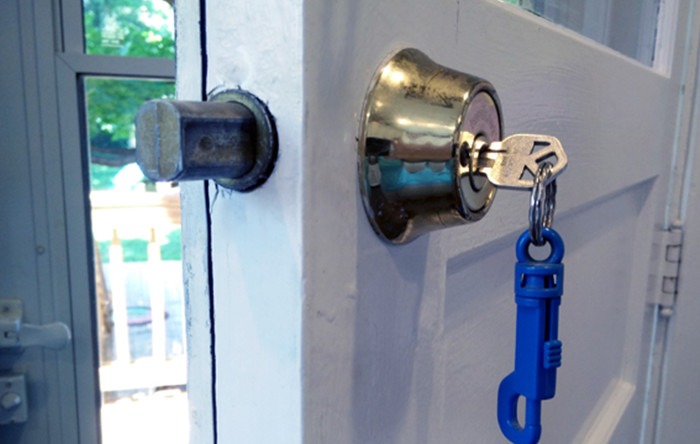Congratulations on your new home! Now the fun of unpacking and settling in begins. At the top of your to-do list should be a quick and easy inspection to self-evaluate the safety of your new home. Learn what steps can make your home more safe, so you can begin enjoying it worry-free.
From odorless gasses and fire hazards to faulty deadbolts and flimsy doors, it’s possible your new home has some dangers you’ll want to keep your family and loved ones safe from.
As a parent, you want to make sure your new house is as safe as possible for your little (or not-so-little) ones. By following these five steps, you can self-evaluate your home and take the safety measures essential to securing your home.
- Inspect deadbolts
It’s a good idea to change the locks on your doors when you move into a new house. You never know how many spare keys the previous owners gave out to handymen, babysitters, dog walkers, neighbors, etc.

You’ll also want to inspect your deadbolts to make sure they are made with quality materials and work effectively. Not sure where to start when evaluating your deadbolts? Here’s a quick list:
- Material: What material is your deadbolt made of? Softer metals, like brass, aren’t ideal for deadbolts. You want a deadbolt made of steel.
- Length: How long is the bolt? You want the bolt to extend at least one inch into your doorframe, otherwise it could be pried open.
- Cylinders: The metal part where you put the key in is called a cylinder, and you want a free-spinning or tapered cylinder in order to prevent someone from using a wrench or force to remove it.
Note: A double cylinder deadbolt is pictured above, but it may pose as a safety hazard during a home fire because occupants can only unlock the door if they have a key. Single cylinder dead locks (with an unlocked twist mechanism on the inside of the door) do not have this problem, and therefore are most commonly used on fire exits. Some areas have fire safety codes that do not allow a locked exit.
The next step is to make sure you use your deadbolts. Get family members into the habit of locking the door with the deadbolt while at home, and while away.
- Inspect exterior doors
Before you replace your door locks and check your deadbolts, you’ll want to make sure the door itself is a good one. If it’s not, it is likely worth it to invest in a strong, secure door.
Check to see if your exterior doors are solid-core doors, which are solid all the way through (which doesn’t mean they are solid-wood doors, but that’s okay). Solid-core doors are heavy, and can take more pressure and abuse. They also provide better fire protection than hollow-core doors.
Hollow-core doors are lighter and a lot easier to get through. Usually, hollow-core doors are used as interior doors, but you never know when one will turn up as an exterior door.
Pay attention, too, to the door providing access between your garage and your home. You should have a solid-core door here, too, as you don’t want a burglar to have easy access to your house should they get into the garage.
Also consider replacing any exterior doors made with glass that can easily be broken. You don’t want an intruder to break the glass, reach inside, and unlock the door.
- Evaluate the vegetation
Don’t neglect the outside of your home during your home safety self-evaluation. Take a walk around the exterior of your home, and your yard, and check to see what kind of cover a burglar could find.
While plants and trees along your home can be pretty, they can also provide great coverage for someone trying to break into your house. You can enjoy vegetation around your home, but make sure it is well-pruned and not overgrown.

If you’re planning to do some landscaping at your new home, make some smart home-security minded choices. Consider adding plants with thorns. Nobody wants to mess with a thorny rose bush or other prickly plant.
Choose hedges or shrubbery three-feet-tall or shorter, and cut back any plants along the house that provide a good hiding place under windows. You can also place gravel under windows and along the edge of your home, so anyone walking there wouldn’t have a quiet footfall.
Read more about which home security mistakes you don’t want to make.
- Inspect outdoor lighting
Does your new home pass the outdoor lighting test? Outdoor lights go way beyond being decorative. Adequate outdoor lighting on porches, in doorways, on garages, and along your driveway and walkways can be a great home security measure. Also light up front and back yards, and areas where a burglar may be able to hide.
Consider motion sensors for the front and back of your house. Motion sensors pick up any movement within a certain range and a light turns on when motion is detected. Read more about the five most effective motion sensor lights under $50.
You can also use outdoor lights on timers, programming them to come on at dusk every night, eliminating the need to remember to turn on the outside lights. Also mount lights out of reach, so they can’t easily be tampered with.
- Check for fire and carbon monoxide detectors
Your home should have come equipped with fire and carbon monoxide detectors. But you’ll want to double check that they are functional. It’s also a good idea to replace the batteries in all detectors—you never know when the last homeowner replaced them, and how little life they have left.
Make sure there are carbon monoxide and smoke detectors on every floor of your home, including the basement. Also place them in the hallways or areas outside bedrooms.

Want to learn more? Read seven lifesaving smoke alarm safety tips every parent should know.
Following these home safety self-evaluation tips could make your new home an even safer space to live in. Check your home out, and enjoy some peace of mind.


